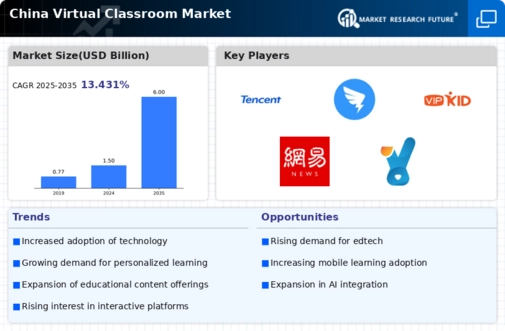Growing Emphasis on Lifelong Learning
The concept of lifelong learning is gaining traction in China, significantly impacting the virtual classroom market. As the job market evolves, professionals are increasingly seeking opportunities to upskill and reskill through online courses. This trend is reflected in the rising enrollment numbers in virtual classroom programs, with a reported increase of 30% in adult learners participating in online education since 2023. The flexibility and accessibility of virtual classrooms make them an ideal solution for working individuals aiming to enhance their qualifications. Consequently, the virtual classroom market is likely to expand as more professionals turn to online learning platforms to meet their educational needs and career aspirations.
Increased Focus on Educational Equity
In China, there is a growing focus on educational equity, which is driving the expansion of the virtual classroom market. Efforts to bridge the educational gap between urban and rural areas have led to increased investments in online learning solutions. The government and private sector are collaborating to provide access to quality education through virtual classrooms, ensuring that students in remote regions can benefit from the same resources as those in urban centers. Reports suggest that the virtual classroom market could see a growth rate of 25% annually as these initiatives take effect. This emphasis on educational equity not only enhances access to learning but also promotes a more inclusive educational landscape, further solidifying the role of virtual classrooms in China's education system.
Government Initiatives Supporting E-Learning
In China, government initiatives play a crucial role in bolstering the virtual classroom market. The government has implemented various policies aimed at promoting digital education and enhancing the quality of online learning. For instance, the Ministry of Education has allocated substantial funding to develop digital infrastructure in schools, which is expected to increase the adoption of virtual classrooms. Reports indicate that investments in educational technology could reach up to $10 billion by 2026, reflecting the government's commitment to modernizing education. These initiatives not only facilitate access to virtual classrooms but also encourage educational institutions to adopt innovative teaching methods. Consequently, the virtual classroom market is likely to benefit from these supportive measures, fostering a more robust e-learning ecosystem across the country.
Rising Demand for Flexible Learning Solutions
The virtual classroom market in China experiences a notable surge in demand for flexible learning solutions. As educational institutions and corporate training programs seek to accommodate diverse learning styles and schedules, the virtual classroom market becomes increasingly relevant. A report indicates that approximately 70% of learners prefer online courses due to their convenience and accessibility. This trend suggests that the virtual classroom market is well-positioned to cater to the needs of both students and professionals seeking to balance education with other commitments. Furthermore, the ability to access learning materials anytime and anywhere enhances the appeal of virtual classrooms, making them a preferred choice for many. As a result, the virtual classroom market is likely to expand, driven by this growing preference for flexibility in learning environments.
Technological Advancements in Online Learning Platforms
Technological advancements significantly influence the virtual classroom market in China. The integration of cutting-edge technologies such as artificial intelligence, augmented reality, and interactive tools enhances the learning experience. For instance, AI-driven analytics can provide personalized learning paths, catering to individual student needs. Additionally, the incorporation of virtual reality in online education allows for immersive learning experiences that were previously unattainable. As of 2025, it is estimated that the market for educational technology in China will reach approximately $50 billion, with a substantial portion attributed to virtual classroom solutions. These advancements not only improve engagement but also increase the effectiveness of online learning, making the virtual classroom market an attractive option for educational institutions and learners alike.

















Leave a Comment